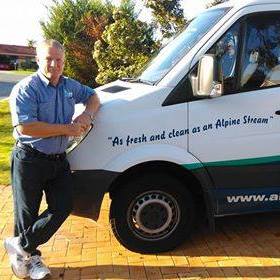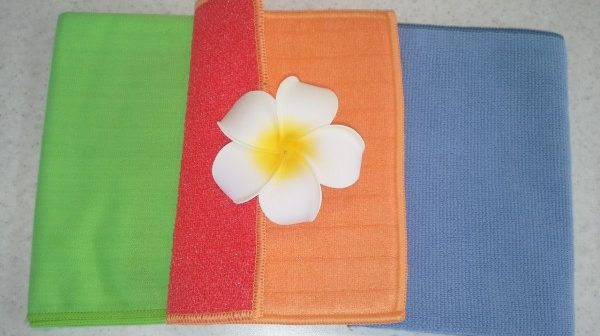Chemical Cleaning v Chemical Free Cleaning
The majority of chemicals we use in our home are not necessary. Many are sold to us by advertisers claiming the product will deliver the Holy Grail if you buy it. Once you get it home and use it you find it is like all the rest – absolute useless! Not only will it not clean for the purpose it was bought, but it leaves chemical streaks everywhere. Let us show you how to use chemical free cleaning.
Just how often have you “cleaned your fingers to the bone “to turn around and see all those chemical streaks? And what did you say to yourself? Words like. “I just cleaned that” or “what a waste of time that was”.
You are not alone. Been there, done that and I have even bought the T-shirt. So what is the answer?
Chemical Free Cleaning Using Microfibres
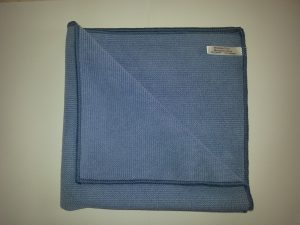
Yes, microfibre cleaning is the answer to all those cleaning problems. However do not be conned into buying really expensive ones as they will do no better at cleaning than most of the cheaper ones that you can easily purchase from local shops and hardware stores. Regardless of cost, all give superior cleaning results than that of chemical cleaning.
A word of advice on purchasing your cloths, stay away from companies claiming that theirs are so called “fibre technology” and as such are superior …all microfibre cleaning cloths come under the heading “fibre technology“. Companies who use that term, use it because they know they will get more money out of you. (It is called marketing, it sounds fancy)!
My mind set is why spend hundreds of dollars for a product/s that are no better than a product/s that cost 90-95% less. All these products cost just a few cents to manufacture regardless of the brand, yet some are being sold for astronomical, even extortionate prices, so be warned.
What is the difference between chemical cleaning and microfibre cleaning?
CHEMICAL CLEANING in general is used to break down oils, fats and grease. These hold onto the soiling you see. The chemical cleaner you buy contains just 3-5% of chemical and 95-97% water (we are being ripped off). However, water or H20 is in itself a cleaning solvent. It will absorb or dissolve as much soiling (particle matter) as the water itself weighs, so water in its own right is a very efficient cleaner. However water is not very good at breaking apart the oils, fats and grease, that is why you need the alkaline based chemical to split apart the surface tension so that the water can get to the surface and do its job:- CLEAN!
Water evaporates but chemicals do not, so unless you have neutralised them they will become visual streaks on the surfaces. A dry cloth can remove most of this residue but not entirely, so your cleaned surface will still have a sticky chemical residue which will attract soiling, only this time much more quickly.
MICROFIBRE CLEANING in the main uses no chemical just water. So how do they work without the chemicals? Understanding how microfibre cloths are designed will help.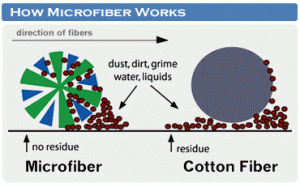
Microfibres are manufactured using a state of the art splitting process, to create wedge-shaped fibres of polyester/polyamide that are 1/100th of a human hair. The gaps between these wedges are small enough to absorb oils, fats grease and bacteria.
The microfibres used for cleaning cloths are normally a mixture of polyester and polyamide. Percentages seen on a cloth tag as 80/20- 60/40 refer to % of polyester to polyamide. The greater the % in polyester the softer the cloth, the higher the polyamide % the more absorbent. Polyesters like to bind to fat, which is why the cloths can be used to wipe away grease without adding detergents. Polyesters however don’t like to bind water. Most polyamides do, but the water absorption of the microfiber cloths comes mostly from a clever production technique that increases the surface area of the fibres and allows for capillary action to suck up the water. 10 times more absorbent than terry towelling, plus each cloth will hold ten times its own weight in soiling before you need to rinse it. Impressive, yes?
Microfibre is considered superior to standard fibres for many cleaning applications because it has more surface area, and the smaller fibres can get into cracks and crevices too small for other materials. Also, the split fibres add cleaning power. The spaces between the splits collect dirt and dust rather than just pushing it around. The microfibre cloths can then be rinsed or washed to remove the embedded particles and reused several hundreds of times. The expected lifetime (usability before replacement) of the cloths are worked out in a laboratory testing facility using a standard washing machine. The reason being that the cloth will not normally get that amount of agitation in normal use, so if the manufacture claims that it is a 600 machine wash product then what they really mean is that in the average household it will last you around 3 years before you need to replace it. Impressed, yes?
Now that I have blinded you with all the facts you can see that this technology, which incidentally has been around since 1950’s, is based on science, good down to earth science that we can all understand. It is a proven technology that will do exactly as it claims. In doing so it will save you buying all those nasty chemicals that do not work that well plus financially it will save the average household $275-$450 per year in cleaning chemical costs.
Once you take all that into account, you will realise that cleaning with chemical free microfibre cloths makes sense not just to you but to our planet also. Reducing your cleaning chemical footprint by 90% or more.
So Why Aren’t Microfibre Cloths Commonly Used?
Most cleaning chemical products are manufactured to be quickly replaced, so it would not be in the interest for any major manufacture to take the microfibre products on board as resale would not be viable over the long term. Profit margins would slump and the company would find it difficult to survive if all they sold were microfibres. So microfibre remains in the speciality area and that alone slows down the education of the general public, of which the chemical cleaning companies are very grateful for.
Fortunately with the internet and social media more facts are getting out and more and more people are turning to these products as an alternative. 17 years ago you heard nothing about them and yet they were invented way back in the 1950’s. Now you type in microfibre cleaning cloths in Google and you will find thousands of suppliers.
How do you get started?
You will only need a couple of multi-purpose cloths and a couple of fine finish glass cleaning cloths to get started.
Microfibre cloths have a myriad of uses, that is why they are so useful. A typical 600 machine wash cloth (good quality, long lasting) should only set you back a maximum of $10 – $15 each.
We are setting up an on line store soon where you can order these high quality products direct. The cheaper ones I referred to earlier in the text will do the job well enough, but they are not long lasting and around 40% less efficient. I use them myself for garden, workshop and painting or anywhere I know I will have to dispose of them immediately after use.
Just Think
If every household in Australia and commercial cleaning business used just two microfibres each day instead of chemicals, at least three major chemical manufacturers would be out of business. Not to mention that Australia would have just saved around two stadiums full of plastic chemical containers that no longer have to go in landfill.
So what will you choose now – Chemical Cleaning or Chemical Free Cleaning?
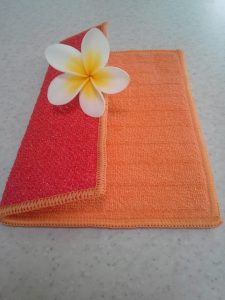
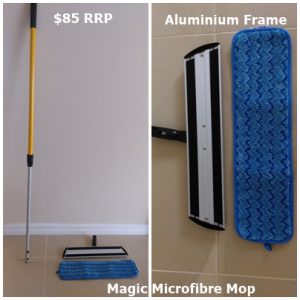
Happy Chemical Free Cleaning from the Cleaning Guru team!
BLOGGER: Paul Mitchell, Owner/Operator of Alpine Carpet & Tile Cleaning, Perth.
